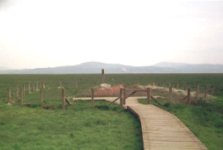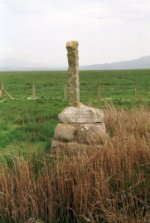BORDER LIFE
The Covenanters
The story of the Covenanters is, strictly speaking, outside the chronological and geographical limits of this web site. However, visitors to the Borders are likely to come across the name quite frequently, especially if they visit South West Scotland. Some, no doubt, will wonder who these people were. It would be a shame, I think, if they were to go back home not knowing and, perhaps, visiting some of the sites relating to them.
Their story is very complex and so many accounts of the Covenanters come in a tomb of a book and does not make light holiday reading so I have attempted to provide this very abbreviated account.
The Story of the Covenanters
His son, Charles I, who was convinced of his divine right to rule, continued this policy even more forcefully. The Scottish Presbyterians, whose belief that Christ and not the king was head of the Church, and their strong opposition to being anglicized, realise that a clash with the king was inevitable.
Incited by an English-style prayer book being introduced into Scottish kirks in 1637, and the gradual erosion of their practices, a huge wave of protestations broke out and London was flooded with complaints. The king’s answer was to order that the use of the prayer book be enforced, and that all dissenters were to be punished.
The Scots closed ranks and a declaration or covenant was drawn up, demanding certain rights. It made a number of demands, including that Scotland be governed by an independent parliament free from the king’s interference, and to be allowed to control the kirk according to their own rules and beliefs. It pledged to defend their religion against all outside
interference and to continue the struggle against ‘popery.’
The King’s Commissioner to Scotland was swept aside and a Scottish Assembly was established.
The King had no standing army to enforce his will and played for time by attempting to placate the Assembly. The Scots, preparing for the inevitable, steadily built up their army, and appointed in charge a very able general, Alexander Leslie. Another talented leader, James Graham, the 5th Earl of Montrose, rallied support in the north and east He
was to feature largely in subsequent events. King Charles succeeded in raising an ill equipped and untrained army of 20,000.
In 1542 the English Civil War broke out and two years later Leslie took his army south at the request of Crowell’s Parliamentarians, and, together, they defeated the Royalists at Marston Moor, in Yorkshire.
Not all Scots supported the Presbyterians. There were those who thought they carried the execution of their doctrine to excess and, when local magistrates became involved, moral delinquents and backsliders were severely punished and humiliated. Pockets of Catholics continued to flourish, some being led by influential nobles.
Like so many systems, extremists emerged and enforced their beliefs to excess Attacks were made on Christmas traditions, and all forms of dancing, singing and merrymaking. A law was passed forbidding all work on Sunday, and any form of recreation. Attendance at the Kirk was compulsory and offenders were humiliated. As time went on punishments became more
severe thus further alienating the people.
The Earl of Montrose had now changed sides and, leading a powerful, well-trained army of Highlanders set about attacking the Covenanters wherever he could find them. After a whole series of victories, Leslie defeated him at the Battle of Philiphaugh. (Read about the battle) and the Scots captured the English King Charles at Newark.
Later, after the restoration of the monarchy, support for the Covenanters continued to wane. The Scottish government restored the rule of the Church of Scotland and repressive measures against the Covenanters were increased and extended. Strong measures were introduced to put a stop to Covenanter services. Known as coventicles, they were banned on pain of
death. Only in the South West of Scotland did the Covenanters continued their worshipping, but they were ruthlessly hounded by Government forces and their services were held in secret location in the hills. Many a service was ambushed by government troops and the congregation dispersed or killed.
Military action against the Covenanters was merciless. Government troops sought to root out all those who persisted to adhere to the Covenanter ethos. Their services were known as conventicles and the army was ordered to put a stop to them.
Men like Graham of Claverhouse and Grierson of Lagg earned notoriety for being most brutal and vigorous in pursuing all those who continued their faith. Searches were conducted over the rolling hills and in the farmsteads and villages and all known adherents were killed
on sight if they did not promptly deny their faith. Many were not given the opportunity.
Probably the most appalling case of cruelty against the Covenanters occurred near Wigtown in South West Scotland.
Four women, who were caught practising the faith, were brought before the court and charged with rebellion. They were found guilt and ordered to receive sentence on their knees. When they refused, they were brutally forced down to the ground. One, Margaret Maclachan, a widow aged 70 years, and Margaret Wilson, a farmer’s daughter, were both sentenced to
die by drowning. Margaret Maxwell, a serving maid, aged 20 was sentenced to be flogged through the streets of Wigtown on three successive days., and the father of Agnes Wilson, sister of Margaret, aged 13, was ordered to pay a bond of £100 to ensure her good behaviour.
The townsfolk were shocked by the barbarity of the sentences, and when Margaret Maxwell’s punishment was carried out, the streets were deserted.
The other two women were tied to stakes at low water. As the cold waters crept up to their heads, they sang a plaintive hymn. Then their lives were extinguished by the waves.
Graham of Claverhouse
Known as Bonnie Dundee and Bloody Claverhouse depending upon whose you were on. He was charged by the Scottish parliament to eliminate Covenantism from the southwest and he carried out his allotted task with enthusiasm. He was particularly active in the Moffat area. He and his men established a base in the town from
where he could pursue Covenanters and suspect among the hills.
Eventually, Claverhouse felt able to boast “this country is now parfait peace.”
John Hunter
Alongside the main road overlooking the Devil’s Beeftub, near Moffat a memorial stone can be seen. Hunter had been pursued by Claverhouses‘s dragoons and was shot and killed as he made his way across the valley.
The whole episode was involved the activities of two extremist groups and many atrocities were committed before some sort of normality was restored.
Although Puritanism was largely extinguished old habits die hard and the legacy of their beliefs still linger in many parts of Scotland. Observance of The Lord’s Day is very strong in parts of Scotland and among certain family.

|

|
Covenanters. Hopeless cases committed to hopeless causes. Ten thousand martyrs, but no saints. The sad thing is, there's practically no point now in trying to explain what they fought and died for.
W. Gordon Smith, Mr. Jock.